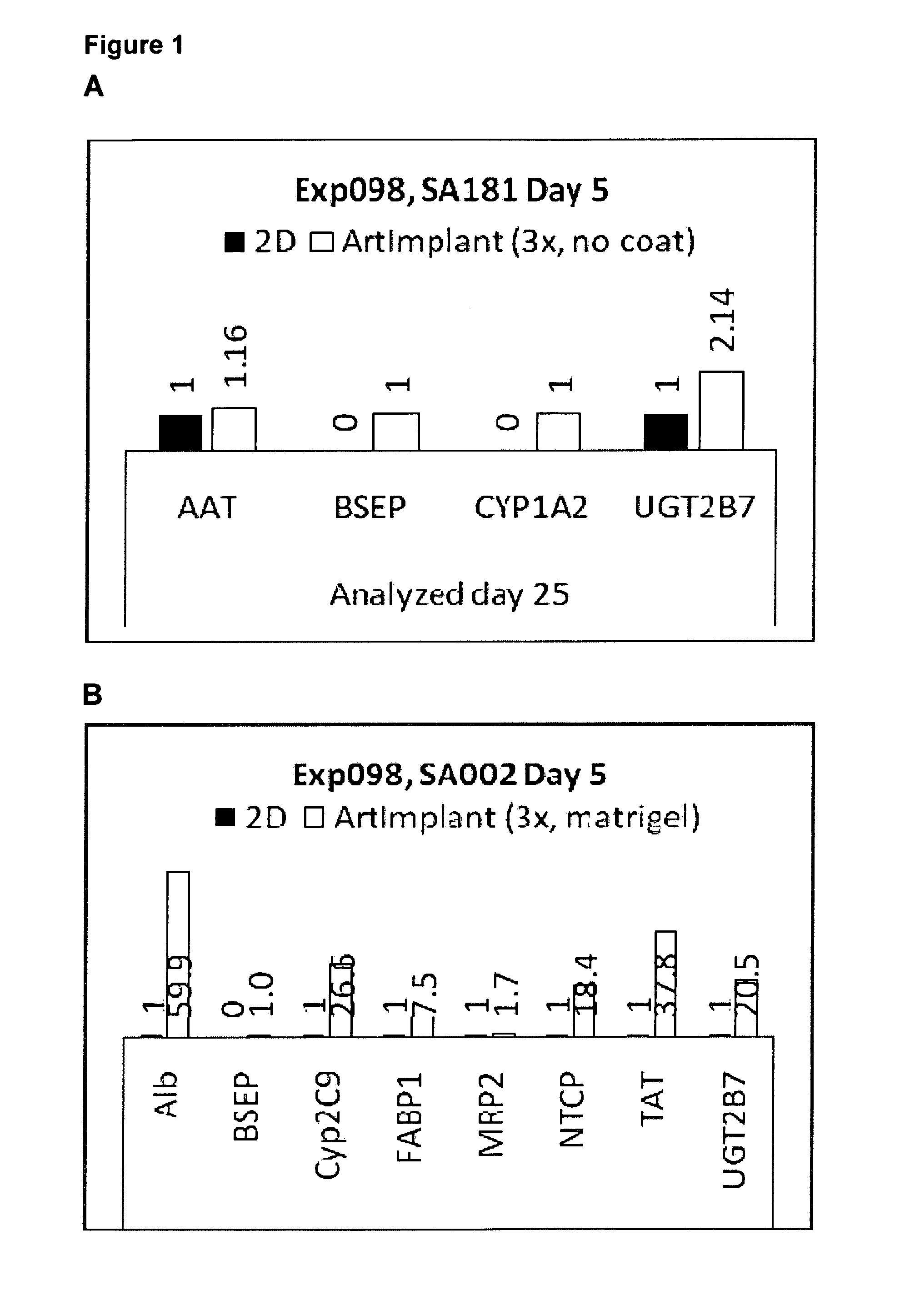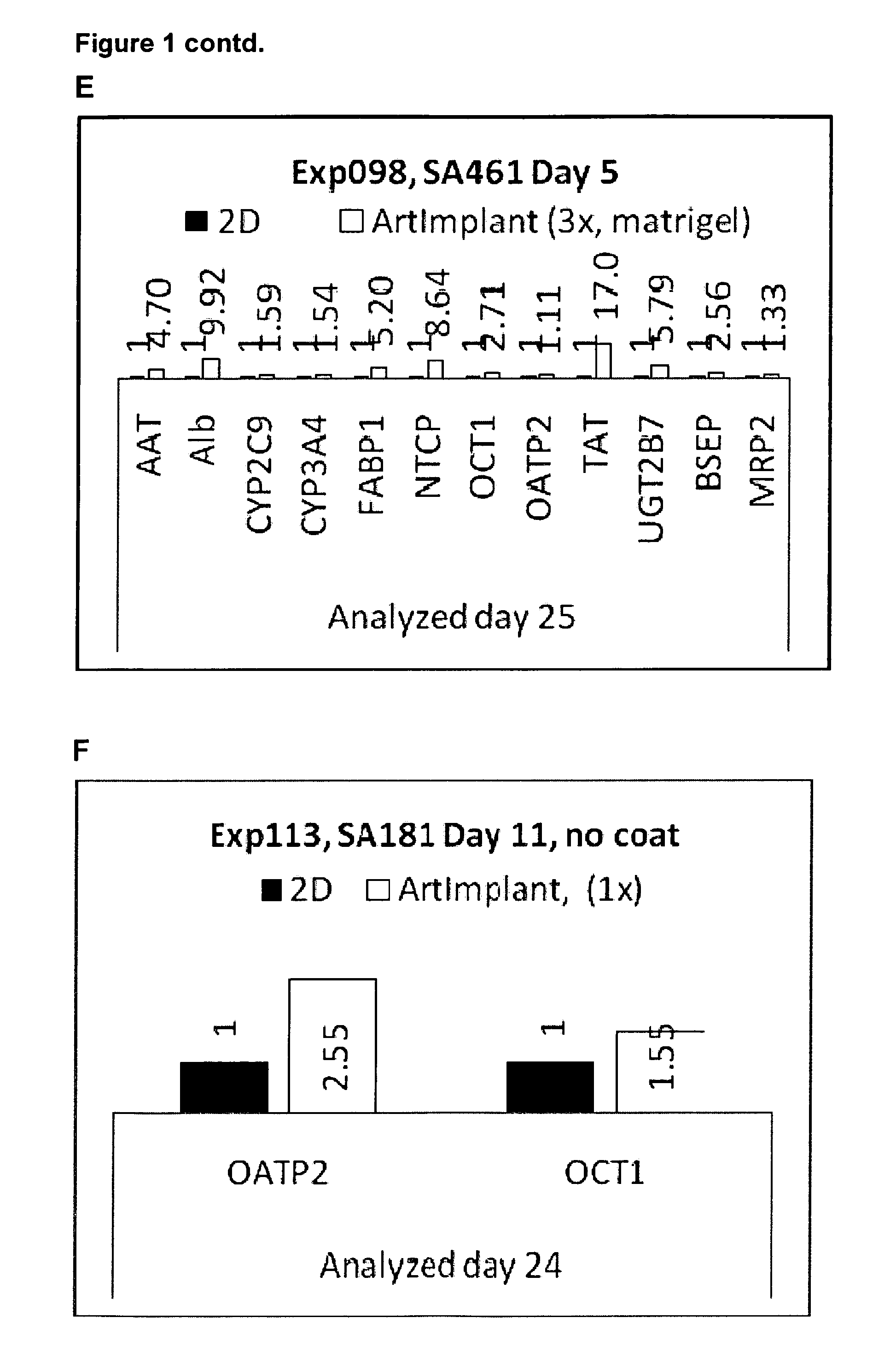3-dimensional scaffolds for improved differentiation of pluripotent stem cells to hepatocytes
a technology of pluripotent stem cells and scaffolds, applied in the direction of artificial cell constructs, biocide, drug compositions, etc., can solve the problems of limited use in regenerative medicine, differentiation cells lacking the characteristic phenotype of mature cell types, and cells derived from primary sources are often very limited in their capacity to be further propagated
- Summary
- Abstract
- Description
- Claims
- Application Information
AI Technical Summary
Benefits of technology
Problems solved by technology
Method used
Image
Examples
example 1
[0076]Starting Material for Hepatocytes Derived from Human Pluripotent Stem Cells
[0077]All hPS cells (as defined above) can be used as staring material for this invention. For the examples below hepatocyte-like cells were derived in vitro from undifferentiated human embryonic stem cells (hESC) cultured on mEF cells (Heins, N. et al. 2004, Stem Cells). The cell lines used for this experiment could be, but is not limited to the hES cell line SA002, SA121, SA181, SA461 (Cellartis AB, Göteborg, Sweden, http: / / www.cellartis.com) and they can be propagated as described Heins, N et al. 2004. These cell lines are listed in the NIH stem cell registry, the UK Stem Cell bank and the European hESC registry and are available on request. Along with hPS obtained from hESC, hPS obtained from hiPS (induced pluripotent stem cells) have been used for the derivation of hepatocytes for the examples of this invention. In this case, “hiPS-HEP” is intended to mean a cell type derived from induced pluripote...
example 2
[0078]Derivation of Hepatocytes from Human Pluripotent Stem Cells Using 3D Scaffolds.
[0079]Hepatocytes were derived from both hES cells and human hiPS cells according to the protocols a-e, as detailed below. Before start of differentiation, the cultures were washed twice with PBS. The different media (Table 1) were prepared freshly and added from day 0 and afterwards according to the protocol overview. Medium was changed every day or every second day during the initial differentiation (ID) step, and every second or every third day afterwards. Only one cell line was used for each experiment, but optionally a second (or more) cell line could be added when the initial cell line is seeded onto the 3D scaffolds allowing co-culturing of the cells.
[0080]2D cultures were seeded on matrigel coated culture vessels, except in experiment 114 and 116 when 2D cultures were seeded on gelatin coated culture vessels. 2D cultures were seeded in 150.000-200.000 cells / cm2.
[0081]The table below shows an...
example 3
Scaffolds
[0082]Scaffolds and Matrix Coatings Used in the Studies
[0083]Artelon (Artimplant); <150 μm poresize, formatted for 48 well plates, kindly provided by Artelon (Artimplant) (Västra Frölunda, Sweden) [see WO0035507; also Blumenthal, B. et al. (2010)]
[0084]Alvatex; size for 48 wells, kindly provided by Stefan Przyborski ReInnervate, (Durham, UK) (see WO07125288, WO10038013)
[0085]AlgiMatrix; Invritogen / Gibco, cat no 12684, lot nr 731950, 96 wells (exp088+089) [see WO08112904; also Shapiro, L & Cohen, S. (1997)]
[0086]UltraWeb; Corning, cat no 3873xx, lot no 09207043, 96 wells (exp088+089) [see WO09032117; WO10060066, also Piryaei, A. et al. (2010)]
[0087]Aggrewell; Stem Cell Technologies, cat 27865, approx. 300 microwells, [see WO2008106771]
[0088]HAC / Porocell; (HacBiomed); [Cell Transplant. 1997 September-October; 6(5):463-8.
[0089]Highly porous polymer matrices as a three-dimensional culture system for hepatocytes.
[0090]Kaufmann P M, Heimrath S, Kim B S, Mooney D J.]
[0091]Preparat...
PUM
 Login to View More
Login to View More Abstract
Description
Claims
Application Information
 Login to View More
Login to View More - R&D
- Intellectual Property
- Life Sciences
- Materials
- Tech Scout
- Unparalleled Data Quality
- Higher Quality Content
- 60% Fewer Hallucinations
Browse by: Latest US Patents, China's latest patents, Technical Efficacy Thesaurus, Application Domain, Technology Topic, Popular Technical Reports.
© 2025 PatSnap. All rights reserved.Legal|Privacy policy|Modern Slavery Act Transparency Statement|Sitemap|About US| Contact US: help@patsnap.com



